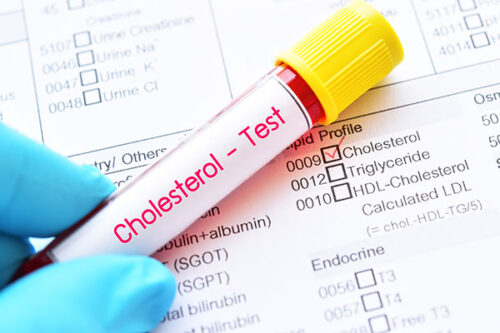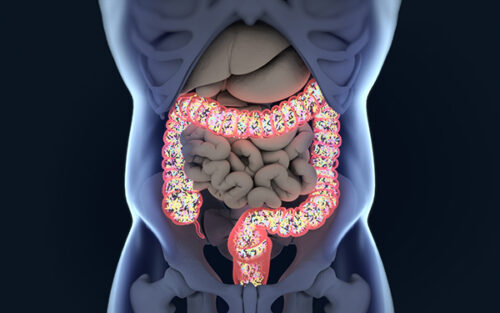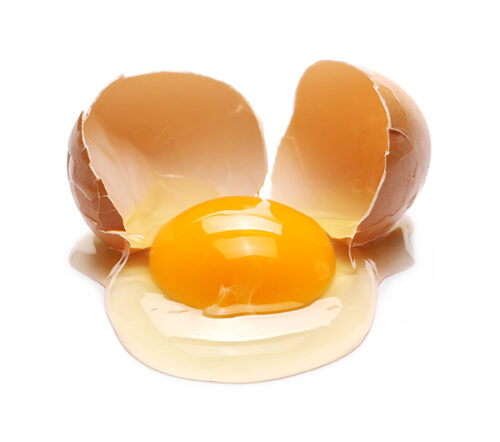Cholesterol When and How to Treat It

By John McDougall, MD
Elevated cholesterol is one of the most common health worries among people of Western cultures. One reason for this heightened awareness is the sale of a class of powerful and expensive cholesterol lowering agents, known as HMG-CoA reductase inhibitors and commonly called “statins.” They are advertised to where they are now among the most commonly prescribed medications. Pharmaceutical companies don’t want you to know about this risk factor for heart disease. They never mention that “no one dies from a high cholesterol;” they, rather, die when the arteries fail from years of unhealthy eating. The solution is a change in diet rather than pills. Even so, elevated cholesterol is a real crystal ball to your future and should not be ignored.
What is Normal Blood Cholesterol?
Normal cholesterol was once based upon what was common for Americans. Their average cholesterol is 210 to 220 mg/dl. This was considered the desirable range until someone noticed that the average American was sick. The average American has a 50% chance of dying prematurely of heart disease or stroke. Average is overweight or obese. Even diabetes has become the norm. “Average” you don’t want to be. So about 35 years ago recommendations for “desirable” cholesterol levels began to be used in laboratories and medical practices. Unfortunately, to date, there are few official recommendations for an “ideal” cholesterol: the cholesterol level associated with the best possible health, and more specifically, the lowest risk of dying of heart disease. That is where my recommendations lead to.
Standard recommendations and McDougall’s recommendations for blood lipids (various fractions of cholesterol and triglycerides) are the following (in mg/dl):
Total cholesterol levels
- a) Less than 200 = desirable
- b) 200-239 = borderline high
- c) 240 or above = high
- d) McDougall = less than 150 mg/dl
LDL cholesterol level, or so-called “bad” cholesterol
- a) Less than 100 = optimal
- b) 100-129 = near optimal/above optimal
- c) 130-159 = borderline high
- d) 160-189 = high
- e) 190 and above = very high
- f) McDougall = less than 90 mg/dl
HDL cholesterol levels, or so-called “good” cholesterol
- a) Less than 40 = low
- b) 60 or above = high
- c) 40-60 = optimal
- d) McDougall = higher is better, but a healthy diet makes this fraction of total cholesterol lower because all fractions of cholesterol are reduced. So don’t be misguided into thinking something is wrong when your HDL level falls with a healthy diet.
Triglyceride levels
Triglycerides are less important predictors of heart disease risk than cholesterol.
- a) Normal less than 200 mg/dl
- b) High = 200 to 500 mg/dl
- c) Very high = in the thousands
- d) McDougall = less than 150 mg/dl
Why Ideal Cholesterol is Below 150 mg/dl:
Worldwide and nationwide heart disease is very rare when people have blood cholesterol levels below 150 mg/dl.1,2 This is why I have set this value for your laboratory results as “a great big A+” on the report card. This level can be attained by almost everyone by following a strict low-fat, no cholesterol diet, such as I recommend, and judicious use of medications.
Who Should Get Medication?
I’m not sure, but I am called upon to make my best guess with my patients every day.
The most recent guidelines of the Expert Panel on Detection, Evaluation, and Treatment of High Blood Cholesterol in Adults considered that an ideal LDL cholesterol level is below 100 mg/dl and recommended that persons with coronary heart disease or similar high risk should be considered for drug therapy when LDL is equal to or greater than 130 mg/dl.(3) However, some doctors are even more aggressive and recommend medication when LDL cholesterol of less than 100 mg/dl cannot be obtained with diet and lifestyle changes alone.3
My goal is to have all my patients achieve total cholesterol below 150 mg/dl (and LDL cholesterol below 90 mg/dl) with diet alone. So, what do I recommend for those who cannot accomplish this with diet alone?
I have little hesitation recommending they take relatively safe “natural” cholesterol-lowering medications like berberine, garlic, oat bran (oatmeal cereal), vitamin C, and/or gugulipid for those who have tried without success. 3a,3b
Natural Cholesterol Lowering Medications (LDL cholesterol):
| Preparation | Dosage (daily) | % Reduction Expected |
| Berberine | 0.5 g and 1.5 g/day | 35-45 |
| Garlic | 1/2 to 1 clove | 7-9 |
| Vitamin C | 2 grams | 12 |
| Vitamin E (dry) | 200 IU (mg) | 15 |
| Oat bran | 2 oz. (3 oz, cereal) | 3 to 10 |
| Gugulipid | 500 mg 3 x a day | 21 |
Other “natural supplements” found to lower LDL-cholesterol include: Sterol/stanols and vegetable proteins (7-10%), lupin (8%), soy proteins (3-7%), polyphenols, quercetin, resveratrol, and curcumin. 3a
I once recommended Niacin. I do not now. Niacin can be very toxic to the liver, especially when taken in time-released forms. There is also an increased risk of stroke when taken with statins. 3c
Berberine is a powerful and “natural approach” with excellent cost and safety profiles that has been introduced. These are considered “Naturally Occurring PCSK9 Inhibitors.” See below for information on prescription PCSK9 Inhibitors. Berberine is purchased through retailers as common as Amazon.
Use of Prescription Medications:
The decision to use prescription medications is much more difficult. Some of my thoughts when I am trying to help a patient make the right decision are:
1) I find it difficult to condemn a young person to 20 to 30 years of drug therapy just because the cholesterol level is high, unless there are other very strong indications that they are at high risk of heart disease (see 2).
2) People with a high risk of heart disease because of a previous history of heart attack, an alarmingly positive heart test (an angiogram or ultra-fast CT scan), angioplasty, bypass surgery and/or angina (chest pains) are candidates for prescription medications. I tend to treat very cautiously with these medications, and my goal is to get the patient’s cholesterol levels below 150 mg/dl, without serious adverse effects. Other issues such as age, diabetes, hypertension, obesity, family history, and especially, the patient’s own feelings and fears heavily influence my recommendations are taken into consideration.
3) Occasionally, someone has a very alarming history of heart attacks and heart surgery, along with diabetes, and/or obesity; and yet still has low cholesterol (say 140 to 170 mg/dl). In these difficult cases, where I consider them to be still at an unacceptable risk, I will treat them with medications to lower their cholesterol even further (below the ideal of 150 m/dl. Obviously, the low level they had at the time of their problem was too high for them. 4
4) An Ultrafast CT (Heart) Scan will sometimes help me make the decision to recommend treatment. This test looks at the amount of calcium in the heart arteries. Calcium is a reflection of previous inflammation from years of atherosclerosis and does not accurately predict who is going to have a heart attack, but simply indicates a history of previous damage. If someone has a concerning cholesterol level and a “clean” heart scan, then I will tend to avoid recommending medication. If the calcium count was mild to moderately elevated, then I will tend to recommend no drug therapy for now, but a follow-up scan in two years to assess the benefits of any treatments, like diet, exercise and “natural medication.” If the initial scan showed a high calcium count and indicated very serious inflammation in the past, then I will tend to start drug therapy without waiting for a follow-up test.
Prescription Medications:
There are four general approaches to prescription medications:
1) Cholesterol binding agents, called bile acid sequestrants agents are found as powders or pills. They bind cholesterol and bile acids (which form cholesterol) in their intestine and they prevent the absorption into the body; causing them to be eliminated in the stool. Binding agents (Colestid, Questran) can lower total cholesterol by 25% and LDL by 31%, but triglycerides often rise. Their main side effect is constipation.
2) HMG-CoA reductase inhibitors (statins) are very powerful medications that inhibit cholesterol production in the liver. They are easy to take in a pill form and have few side effects. The most common problems are an elevation of liver enzymes due to liver damage (about 2% of users) and a rare, but serious form of muscle damage. Muscle damage at a microscopic level is found in 70% of the statin-treated patients.4a
Total cholesterol levels are typically reduced by 13 to 32% and LDL by 21 to 40%. Triglycerides are reduced by 12 to 24%.
Unfortunately, even though the blood lipids are improved with statins, this class of drugs have been very disappointing when it comes to keeping the patient alive longer. Recently standard recommendations have been to not treat with statins, even for those people with elevated cholesterols, unless the patients has a very high risk of future troubles. 5,5a
I have been prescribing pravastatin (Pravachol) for years because of evidence that it is the most effective drug for lowering the risk of heart attacks and death. (6) The action of Pravachol is different from other statins, in that it does not enter the cells of the body easily and therefore avoids some of the effects within the cells that may cause an increase in risk of atherosclerosis and heart attacks.
3) PCSK9 Inhibitors (alirocumab and evolocumab) are the newest rage in the “war against cholesterol.” 5b These are delivered by injections once every two weeks and cost about $12,000 annually. PCSK9 inhibitor drugs are now approved by the FDA to treat familial hypercholesterolemia. They cause a serious reduction in cholesterol and a significant reduction in heart attack, but their benefits for long-term survival are undetermined to date.
4) Nexletol (bempedoic acid): The effect of NEXLETOL and NEXLIZET on cardiovascular morbidity and mortality has not been determined. This drug inhibits making cholesterol in your liver. The typical dose is 180 mg once per day. The cost is about $400/month for 30 pills. It takes about 8 to 12 weeks for your cholesterol levels to improve.
In Summary:
Everyone should be on a low-fat, no-cholesterol, diet based on unrefined starches with the addition of vegetables and fruits. People with elevated triglycerides should further limit simple sugars, even fruit and juices, because they raise triglyceride levels and may cause rises in total cholesterol levels. 7-9 All people with elevated cholesterol and/or triglyceride levels should consider the “natural” cholesterol-lowering agents. People with a higher risk of complications of atherosclerosis (heart attacks, strokes, death) should consider prescription medications. I still prefer statins alone, rather than PCSK9 Inhibitors and Nexletol, because of the safety, costs, and my familiarity with their use.
Once your cholesterol level is stable (and hopefully ideal) then you should check your blood levels every six to 12 months.
References:
1) Roberts W. Atherosclerotic risk factorsミare there ten or is there only one. Am J Cardiol. 1989 Sep 1;64(8):552-4.
2) Kannel W. Is the serum total cholesterol an anachronism? Lancet. 1979 Nov 3;2(8149):950-1.
3) Executive Summary of The Third Report of The National Cholesterol Education Program (NCEP) Expert Panel on Detection, Evaluation, And Treatment of High Blood Cholesterol In Adults (Adult Treatment Panel III). JAMA. 2001 May 16;285(19):2486-97.
3a) Adorni MP, Zimetti F, Lupo MG, Ruscica M, Ferri N. Naturally Occurring PCSK9 Inhibitors. Nutrients. 2020 May 16;12(5):1440.
3b: Jenkins DJA, Spence JD, Giovannucci EL, Kim YI, Josse RG, Vieth R, Sahye-Pudaruth S, Paquette M, Patel D, Blanco Mejia S, Viguiliouk E, Nishi SK, Kavanagh M, Tsirakis T,
Kendall CWC, Pichika SC, Sievenpiper JL. Supplemental Vitamins and Minerals for Cardiovascular Disease Prevention and Treatment: JACC Focus Seminar. J Am Coll Cardiol. 2021 Feb 2;77(4):423-436.
4) Roberts W. Lipid-lowering therapy after an atherosclerotic event. Am J Cardiol. 1989 Sep 15;64(10):693-5.
4a) Draeger A, Monastyrskaya K, Mohaupt M, Hoppeler H, Savolainen H, Allemann C, Babiychuk EB. Statin therapy induces ultrastructural damage in skeletal muscle in patients without myalgia. J Pathol. 2006 Sep;210(1):94-102.
5) Kazi DS, Penko JM, Bibbins-Domingo K. Statins for Primary Prevention of Cardiovascular Disease: Review of Evidence and Recommendations for Clinical Practice. Med Clin North Am. 2017 Jul;101(4):689-699.
5a) Kristensen ML, Christensen PM, Hallas J. The effect of statins on average survival in randomised trials, an analysis of end point postponement. BMJ Open. 2015 Sep 24;5(9):e007118.
5b) Ichihara K. Disparity between angiographic regression and clinical event rates with hydrophobic statins. Lancet. 2002 Jun 22;359(9324):2195-8.
6) Pasta A, Cremonini AL, Pisciotta L, Buscaglia A, Porto I, Barra F, Ferrero S, Brunelli C, Rosa GM. PCSK9 inhibitors for treating hypercholesterolemia. Expert Opin Pharmacother. 2020 Feb;21(3):353-363.
7) Hollenbeck C. Dietary fructose effects on lipoprotein metabolism and risk for coronary artery disease. Am J Clin Nutr. 1993 Nov;58 (5 Suppl):800S-809S.
8) Hallfrisc. J. Metabolic effects of dietary fructose. FASEB J. 1990 Jun;4(9):2652-60.
9) Swanson J. Metabolic effects of dietary fructose in healthy subjects. Am J Clin Nutr 1992 Apr;55(4):851-6.
Recommended Articles

Stumbling Blocks to Dietary Transition

How to Achieve and Maintain a Healthy Gut Microbiome







